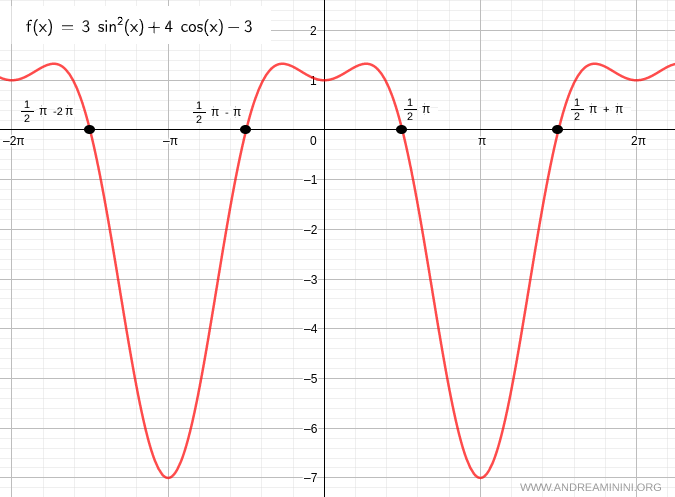How to Simplify and Solve a Trigonometric Equation in Elementary Form
A trigonometric equation involving multiple trigonometric functions can often be rewritten as a simpler, elementary equation.
- Convert all trigonometric functions in the equation to a single reference function (e.g., cosine).
Note: The choice of reference function depends on what simplifies the calculations. Sometimes cosine is the best option, but in other cases, sine or tangent may be more convenient.
- Treat the reference trigonometric function as a variable.
- Solve the equation, breaking it down into simpler trigonometric equations if needed.
A Practical Example
Consider the following equation:
$$ 3 \sin^2 x + 4 \cos x = 3 $$
This equation involves both sine and cosine functions.
In this case, it’s more convenient to use cosine as the reference function.
Using the first fundamental trigonometric identity:
$$ \sin^2 x + \cos^2 x = 1 $$
We can rewrite \( \sin^2 x \) in terms of cosine:
$$ \sin^2 x = 1 - \cos^2 x $$
Substituting \( \sin^2 x \) with \( 1 - \cos^2 x \) in the equation:
$$ 3 \sin^2 x + 4 \cos x = 3 $$
$$ 3 (1 - \cos^2 x) + 4 \cos x = 3 $$
$$ 3 - 3 \cos^2 x + 4 \cos x = 3 $$
This simplifies the equation to involve only the cosine function.
Subtract 3 from both sides to simplify further:
$$ 3 - 3 \cos^2 x + 4 \cos x - 3 = 3 - 3 $$
$$ - 3 \cos^2 x + 4 \cos x = 0 $$
To make the calculation easier, multiply both sides by (-1), reversing the signs:
$$ -1 \cdot ( -3 \cos^2 x + 4 \cos x ) = -1 \cdot 0 $$
$$ 3 \cos^2 x - 4 \cos x = 0 $$
Let \( t = \cos x \) to simplify the equation further:
$$ 3 t^2 - 4 t = 0 $$
This quadratic equation can be solved using the quadratic formula:
$$ t = \frac{-b \pm \sqrt{b^2 - 4ac}}{2a} $$
Here, \( a = 3 \), \( b = -4 \), and \( c = 0 \):
$$ t = \frac{-(-4) \pm \sqrt{(-4)^2 - 4 \cdot 3 \cdot 0}}{2 \cdot 3} $$
$$ t = \frac{4 \pm \sqrt{16}}{6} $$
$$ t = \frac{4 \pm 4}{6} $$
So, the solutions to \( 3t^2 - 4t = 0 \) are:
$$ t = \begin{cases} t = \frac{4 + 4}{6} = \frac{8}{6} = \frac{4}{3} \\ \\ t = \frac{4 - 4}{6} = \frac{0}{6} = 0 \end{cases} $$
Note: Since \( c = 0 \), the solutions can also be found by factoring:
$$ 3 t^2 - 4 t = 0 $$
$$ t (3 t - 4) = 0 $$
This gives \( t = 0 \) or \( t = \frac{4}{3} \).
Since \( t = \cos x \):
$$ \cos x = \begin{cases} \frac{4}{3} \\ \\ 0 \end{cases} $$
However, \( \cos x = \frac{4}{3} \) is not possible because cosine values must lie within \([-1, 1]\). Thus, we discard this solution:
$$ \cos x = \frac{4}{3} = \nexists $$
The remaining solution, \( \cos x = 0 \), is valid:
$$ \cos x = 0 $$
To find \( x \), apply the inverse cosine function:
$$ \arccos(\cos x) = \arccos(0) $$
The inverse cosine of 0 is \( \pi/2 \) radians (90°):
$$ x = \arccos(0) = \frac{\pi}{2} $$
Since cosine is a periodic function with a period of \( \pi \) radians, the solutions are infinite:
$$ x = \frac{\pi}{2} + k \pi $$
Where \( k \) is any integer.
By varying \( k \) (\( k = 0, 1, -1, 2, -2, \ldots \)), we can find all periodic solutions of the equation.
Thus, the solution to the original equation is \( x = \pi/2 \) plus any multiple of \( \pi \).

And so on.
